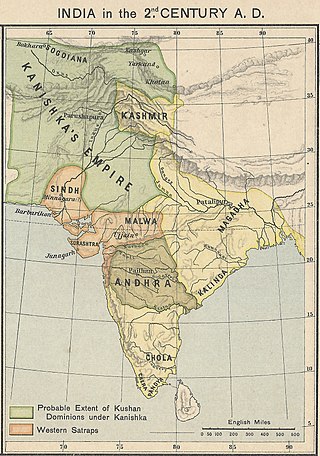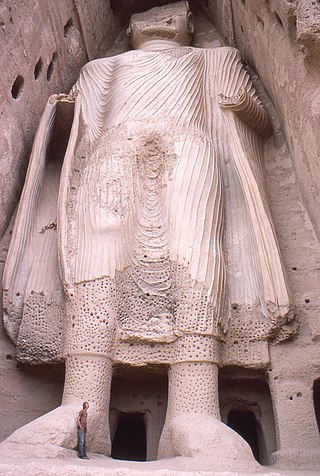
Bactria, or Bactriana, was an ancient Iranian civilization in Central Asia centered on modern day Northern Afghanistan and including parts of southwestern Tajikistan and southeastern Uzbekistan.

Sogdia or Sogdiana was an ancient East Iranian civilization between the Amu Darya and the Syr Darya, and in present-day Uzbekistan, Turkmenistan, Tajikistan, Kazakhstan, and Kyrgyzstan. Sogdiana was also a province of the Achaemenid Empire, and listed on the Behistun Inscription of Darius the Great. Sogdiana was first conquered by Cyrus the Great, the founder of the Achaemenid Empire, and then was annexed by the Macedonian ruler Alexander the Great in 328 BC. It would continue to change hands under the Seleucid Empire, the Greco-Bactrian Kingdom, the Kushan Empire, the Sasanian Empire, the Hephthalite Empire, the Western Turkic Khaganate and the Muslim conquest of Transoxiana.

Kanishka I, Kanishka or Kanishka the Great, was an emperor of the Kushan dynasty, under whose reign the empire reached its zenith. He is famous for his military, political, and spiritual achievements. A descendant of Kujula Kadphises, founder of the Kushan empire, Kanishka came to rule an empire extending from Central Asia and Gandhara to Pataliputra on the Gangetic plain. The main capital of his empire was located at Puruṣapura (Peshawar) in Gandhara, with another major capital at Mathura. Coins of Kanishka were found in Tripuri.
The Hephthalites, sometimes called the White Huns, were a people who lived in Central Asia during the 5th to 8th centuries CE. They formed an empire, the Imperial Hephthalites, and were militarily important from 450 CE, when they defeated the Kidarites, to 560 CE, when combined forces from the First Turkic Khaganate and the Sasanian Empire defeated them. After 560 CE, they established "principalities" in the area of Tokharistan, under the suzerainty of the Western Turks and of the Sasanian Empire, before the Tokhara Yabghus took over in 625.

The Kushan Empire was a syncretic empire, formed by the Yuezhi, in the Bactrian territories in the early 1st century. It spread to encompass much of what is now Uzbekistan, Afghanistan, Pakistan, and Northern India, at least as far as Saketa and Sarnath, near Varanasi, where inscriptions have been found dating to the era of the Kushan emperor Kanishka the Great.

Bamyan Province also spelled Bamiyan, Bāmīān or Bāmyān is one of the thirty-four provinces of Afghanistan with the city of Bamyan as its center, located in central parts of Afghanistan.

The Kingdom of Khotan was an ancient Buddhist Saka kingdom located on the branch of the Silk Road that ran along the southern edge of the Taklamakan Desert in the Tarim Basin. The ancient capital was originally sited to the west of modern-day Hotan at Yotkan. From the Han dynasty until at least the Tang dynasty it was known in Chinese as Yutian. This largely Buddhist kingdom existed for over a thousand years until it was conquered by the Muslim Kara-Khanid Khanate in 1006, during the Islamization and Turkicization of Xinjiang.

Vima Kadphises was a Kushan emperor from approximately 113 to 127 CE. According to the Rabatak inscription, he was the son of Vima Takto and the father of Kanishka.

Vāsudeva I was a Kushan emperor, last of the "Great Kushans." Named inscriptions dating from year 64 to 98 of Kanishka's era suggest his reign extended from at least 191 to 232 CE. He ruled in Northern India and Central Asia, where he minted coins in the city of Balkh (Bactria). He probably had to deal with the rise of the Sasanians and the first incursions of the Kushano-Sasanians in the northwest of his territory.

Bactrian is an extinct Eastern Iranian language formerly spoken in the Central Asian region of Bactria and used as the official language of the Kushan and the Hephthalite empires.

Zabulistan, was a historical region in southern Afghanistan roughly corresponding to the modern provinces of Zabul and Ghazni. Following the Ghaznavid rule (977–1186), "Zabul" became largely synonymous with the name of its capital and main city, Ghazni.

Buddhism, an Indian religion founded by Gautama Buddha, first arrived in modern-day Afghanistan through the conquests of Ashoka, the third emperor of the Maurya Empire. Among the earliest notable sites of Buddhist influence in the country is a bilingual mountainside inscription in Greek and Aramaic that dates back to 260 BCE and was found on the rocky outcrop of Chil Zena near Kandahar.
Shibar, is a district located in the western end of the Bamyan province in Afghanistan. It is in a mountainous region. The main village Shibar is at 2,637 m altitude on the all-seasons secondary road from Bamyan to Kabul through the Shibar Pass.

Ikuo Hirayama was a Japanese Nihonga painter and educator. Born in Setoda-chō, Hiroshima Prefecture, he was famous in Japan for Silk Road paintings of dreamy desert landscapes in Iran, Iraq, and China.
Zunbil, also written as Zhunbil, or Rutbils of Zabulistan, was a royal dynasty south of the Hindu Kush in present southern Afghanistan region. They ruled from circa 680 AD until the Saffarid conquest in 870 AD. The Zunbil dynasty was founded by Rutbil, the elder brother of the Turk Shahi ruler, who ruled over Hephthalite kingdom from his capital in Kabul. The Zunbils are described as having Turkish troops in their service by Arabic sources like Tarikh al-Tabari and Tarikh-i Sistan.
Afghanistan possesses a rich linguistic legacy of pre-Islamic scripts, which existed before being displaced by the Arabic alphabet, after the Islamic conquest of Afghanistan. Among these scripts are Sharada, Kharosthi, Greek, and Brāhmī. For thousands of years, Afghanistan was inhabited by Indo-Aryan and Iranian peoples and thus all ancient documents, tracts, monuments and remains are of Hindu and Iranian origins. Later, Buddhism became the major force in Afghanistan and brought with it its own liturgical languages.

Joe Cribb is a numismatist, specialising in Asian coinages, and in particular on coins of the Kushan Empire. His catalogues of Chinese silver currency ingots, and of ritual coins of Southeast Asia were the first detailed works on these subjects in English. With David Jongeward he published a catalogue of Kushan, Kushano-Sasanian and Kidarite Hun coins in the American Numismatic Society New York in 2015. In 2021 he was appointed Adjunct Professor of Numismatics at Hebei Normal University, China.
Silk Road Numismatics is a special field within Silk Road studies and within numismatics. It is particularly important because it covers a part of the world where history is not always clear – either because the historical record is incomplete or is contested. For example, numismatics has played a central role in determining the chronology of the Kushan kings.
The Turk Shahis or Kabul Shahis were a dynasty of Western Turk, or mixed Turko-Hephthalite, origin, that ruled from Kabul and Kapisa to Gandhara in the 7th to 9th centuries AD. They may have been of Khalaj ethnicity. The Gandhara territory may have been bordering the Kashmir kingdom and the Kanauj kingdom to the east. From the 560s, the Western Turks had gradually expanded southeasterward from Transoxonia, and occupied Bactria and the Hindu-Kush region, forming largely independent polities. The Turk Shahis may have been a political extension of the neighbouring Western Turk Yabghus of Tokharistan. In the Hindu-Kush region, they replaced the Nezak Huns – the last dynasty of Bactrian rulers with origins among the Xwn (Xionite) and/or Huna peoples.

The Seal of Khingila is an historical seal from the region of Bactria, on southern Central Asia. The seal was published recently by Pierfrancesco Callieri and Nicholas Sims-Williams. It is now in the private collection of Mr. A. Saeedi (London). Kurbanov considers it as a significant Hephthalite seal. It has also been considered as intermediate between the Kidarites and the Hephthalites.













